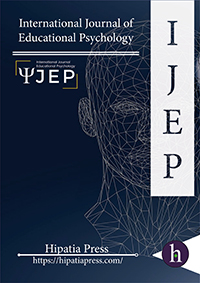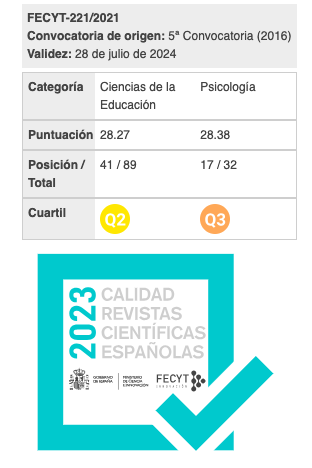How Much Guidance Do Students Need? An Intervention Study on Kindergarten Mathematics with Manipulatives
Keywords:
Downloads
Abstract
Research has shown that the efficacy of learning with manipulatives (e.g., fingers, blocks, or coins) is affected by multiple variables, including the amount of guidance teachers provide during learning. However, there is no consensus on how much guidance is necessary when learning with manipulatives. The goal of this study was to examine the optimal level of guidance during instruction with manipulatives. The focus was on the timing and level of guidance. The researcher taught students a lesson on counting from one to 10 with pennies and nickel strips. Kindergarten students were taught over five consecutive days in one of four conditions: high guidance, low guidance, high guidance that transitioned to low guidance, and low guidance that transitioned to high guidance. Results showed no difference in learning across the conditions. These results provide valuable information to teachers on the areas of mathematics that do not require the effort of high guidance.
Downloads
References
Baroody, A. J., Purpura, D. J., Eiland, M. D., & Reid, E. E. (2015). The impact of highly and minimally guided discovery instruction on promoting the learning of reasoning strategies for basic add-1 and doubles combinations. Early Childhood Research Quarterly, 30(Part A), 93–105. https://doi.org/10.1016/j.ecresq.2014.09.003
Google Scholar CrossrefBruner, J. S. (1961). The act of discovery. Harvard Educational Review, 31(1), 21–32.
Google Scholar CrossrefBruner, J. S. (1966). Toward a theory of instruction. Cambridge, Mass., Belknap Press of Harvard University.
Google Scholar CrossrefCarbonneau, K.J., Marley, S.C., & Selig, J.P. (2013). A meta-analysis of the efficacy of teaching mathematics with concrete manipulatives. Journal of Educational Psychology, 105(2), 380-400. doi: 10.1037/a0031084
Google Scholar CrossrefCarbonneau, K., & Marley, S. (2015). Instructional guidance and realism of manipulatives influence preschool children’s mathematics learning. The Journal of Experimental Education, 1–19. https://doi.org/10.1080/00220973.2014.989306
Google Scholar CrossrefChen, O., Kalyuga, S., & Sweller, J. (2015). The worked example effect, the generation effect, and element interactivity. Journal of Educational Psychology, 107(3), 689–704.
Google Scholar CrossrefClarke, B., & Shinn, M. (2002). Test of early numeracy (ten): Administration and scoring of aimsweb early numeracy measures for use with aimsweb. Eden Prairie, MN: Edformation Inc.
Google Scholar CrossrefCobb, P. (1995). Cultural tools and mathematical learning: A case study. Journal for Research in Mathematics Education, 26(4), 362-385.
Google Scholar CrossrefDarch, C., Carnine, D., & Gersten, R. (1984). Explicit instruction in mathematics problem solving. Journal of Educational Research, 77(6), 351.
Google Scholar CrossrefDeLoache, J. S. (2000). Dual representation and young children’s use of scale models. Child Development, 71(2), 329–338. doi:10.1111/1467-8624.00148
Google Scholar CrossrefFennema, E. H. (1972). The relative effectiveness of a symbolic and a concrete model in learning a selected mathematical principle. Journal for Research in Mathematics Education, (4), 233. https://doi.org/10.2307/748490
Google Scholar CrossrefFuson, K. C. (2009). Avoiding misinterpretations of Piaget and Vygotsky: Mathematical teaching without learning, learning without teaching, or helpful learning-path teaching? Cognitive Development, 24(4), 343–361.
Google Scholar CrossrefFyfe, E. R., DeCaro, M. S., & Rittle-Johnson, B. (2014). An alternative time for telling: When conceptual instruction prior to problem solving improves mathematical knowledge. British Journal of Educational Psychology, 84(3), 502–519. https://doi.org/10.1111/bjep.12035
Google Scholar CrossrefFuchs, L. S., Fuchs, D., Prentice, K., Burch, M., Hamlett, C. L., Owen, R., … Jancek, D. (2003). Explicitly teaching for transfer: Effects on third-grade students’ mathematical problem solving. Journal of Educational Psychology, 95(2), 293–305. https://doi.org/10.1037/0022-0663.95.2.293
Google Scholar CrossrefFyfe, E.R., Rittle-Johnson, B., & DeCaro, M.S. (2012). The effects of feedback during exploratory mathematics problem solving: Prior knowledge matters. Journal of Educational Psychology, 104(4), 1094-1108.
Google Scholar CrossrefFyfe, E. R., & Rittle-Johnson, B. (2016). The benefits of computer-generated feedback for mathematics problem solving. Journal of Experimental Child Psychology, 147, 140–151. https://doi.org/10.1016/j.jecp.2016.03.009
Google Scholar CrossrefHarcourt Assessment Inc. (2002). Stanford achievement test, tenth edition. San Antonio, TX: Harcourt Assessment Inc.
Google Scholar CrossrefHoran, E. M. (2017). Guidance and structure in mathematics instruction: How much guidance do students need? An intervention study on kindergarten mathematics with manipulatives (Doctoral dissertation). Retrieved from https://galileo-usg-uga-primo.hosted.exlibrisgroup.com:443/UGA:UGA:01GALI_USG_ALMA71186079720002931
Google Scholar CrossrefHunt, J. H. (2014). Effects of a Supplemental Intervention Focused in Equivalency Concepts for Students with Varying Abilities. Remedial and Special Education, 35(3), 135–144.
Google Scholar CrossrefJitendra, A.K., Rodriguez, M., Kanive, R., Huang, J.-P., Church, C., Corroy, K.A., & Zaslofsky, A. (2013). Impact of small-group tutoring interventions on the mathematical problem solving and achievement of third-grade students with mathematics difficulties. Learning Disability Quarterly, 36(1), 21-35. doi:10.1177/0731948712457561
Google Scholar CrossrefKalyuga, S. (2007). Expertise reversal effect and its implications for learner-tailored instruction. Educational Psychology Review, 19(4), 509-539. doi: 10.1007/s10648-007-9054-3
Google Scholar CrossrefKirschner, P.A., Sweller, J., & Clark, R.E. (2006). Why minimal guidance during instruction does not work: An analysis of the failure of constructivist, discovery, problem-based, experiential, and inquiry-based teaching. Educational Psychologist, 41(2), 75-86.
Google Scholar CrossrefKroesbergen, E. H., & van Luit, J. E. H. (2002). Teaching multiplication to low math performers: Guided versus structured instruction. Instructional Science, 30(5), 361–378. https://doi.org/10.1023/A:1019880913714
Google Scholar CrossrefKroesbergen, E. H., & Van Luit, J. E. H. (2005). Constructivist mathematics education for students with mild mental retardation. European Journal of Special Needs Education, 20(1), 107–116. https://doi.org/10.1080/0885625042000319115
Google Scholar CrossrefLaski, E. V., Jor’dan, J. R., Daoust, C., & Murray, A. K. (2015). What makes mathematics manipulatives effective? Lessons From cognitive science and montessori education. SAGE Open, 5(2), 1-8. doi: 10.1177/2158244015589588
Google Scholar CrossrefMartinez, R.S., Missall, K.N., Graney, S.B., Aricak, O.T., & Clarke, B. (2009). Technical adequacy of early numeracy curriculum-based measurement in kindergarten. Assessment for Effective Intervention, 34(2), 116-125. doi: 10.1177/1534508408326204
Google Scholar CrossrefMayer, R.E. (2004). Should there be a three-strikes rule against pure discovery learning? American Psychologist, 59(1), 14-19. doi: 10.1037/0003-066X.59.1.14
Google Scholar CrossrefNational Governors Association Center for Best Practices & Council of Chief State School Officers. (2010). Common Core State Standards for Mathematics. Washington D.C.: National Governors Association Center for Best Practices, Council of Chief State School Officers. Retrieved from http://www.corestandards.org/the-standards
Google Scholar CrossrefNational Research Council. (2009). Mathematics Learning in Early Childhood: Paths toward Excellence and Equity (No. 978-0-3091-2806–3). Washington, D.C.
Google Scholar CrossrefPiaget, J. (1977). Epistemology and psychology of functions. Boston, MA: D. Reidel Publishing Co.
Google Scholar CrossrefRamani, G. B., Siegler, R. S., & Hitti, A. (2012). Taking it to the classroom: Number board games as a small group learning activity. Journal of Educational Psychology, 104(3), 661–672. https://doi.org/10.1037/a0028995
Google Scholar CrossrefRittle-Johnson, B. (2006). Promoting transfer: Effects of self-explanation and direct instruction. Child Development, 77(1), 1-15.
Google Scholar CrossrefRogoff, B. (1990). Apprenticeship in thinking: Cognitive development in social context. New York, NY, US: Oxford University Press.
Google Scholar CrossrefSalvia, J., & Ysseldyke, J.E. (2001). Assessment (8th ed.). Boston, MA: Houghton Mifflin.
Google Scholar CrossrefSchwartz, J.E. (1992). "Silent teacher" and mathematics as reasoning. Arithmetic Teacher, 40(2), 122-124.
Google Scholar CrossrefSowell, E. J. (1989). Effects of manipulative materials in mathematics instruction. Journal for Research in Mathematics Education, 20(5), 498–505. doi:10.2307/749423
Google Scholar CrossrefSweller, J., Ayres, P., & Kalyuga, S. (2011). Cognitive load theory. New York, NY : Springer.
Google Scholar CrossrefTerwel, J., van Oers, B., van Dijk, I., & van den Eeden, P. (2009). Are representations to be provided or generated in primary mathematics education? Effects on transfer. Educational Research and Evaluation, 15(1), 25–44.
Google Scholar CrossrefTournaki, N. (2003). The differential effects of teaching addition through strategy instruction versus drill and practice to students with and without learning disabilities. Journal of Learning Disabilities, 36(5), 449-458.
Google Scholar CrossrefUttal, D. H., O’Doherty, K., Newland, R., Hand, L. L., & DeLoache, J. (2009). Dual representation and the linking of concrete and symbolic representations. Child Development Perspectives, 3(3), 156–159. doi:10.1111/j.1750-8606.2009.00097.x
Google Scholar CrossrefVygotsky, L.S. (1978). Mind in society : The development of higher psychological processes. Cambridge, MA: Harvard University Press.
Google Scholar CrossrefWoodcock, R., & Johnson, M. (1989). Woodcock-Johnson Psycho-Educational Battery-Revised. DLM Teaching Resources.
Google Scholar CrossrefDownloads
Published
Almetric
Dimensions
How to Cite
Issue
Section
License
All articles are published under Creative Commons copyright (CC BY). Authors hold the copyright and retain publishing rights without restrictions, but authors allow anyone to download, reuse, reprint, modify, distribute, and/or copy articles as the original source is cited.
















